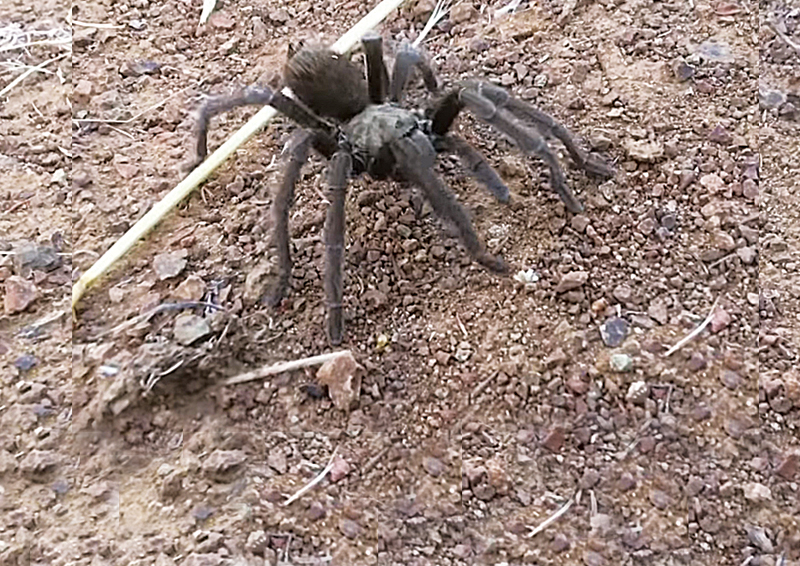Amorous arachnids, migratory birds and the search for East Bay’s oldest redwood

 CONTRA COSTA COUNTY, CA (Sept. 26, 2021) — At least astronomically, autumn began on Sept. 22. So the days are shorter, the air is cooler, the leaves are turning – and the tarantulas are out looking for love.
CONTRA COSTA COUNTY, CA (Sept. 26, 2021) — At least astronomically, autumn began on Sept. 22. So the days are shorter, the air is cooler, the leaves are turning – and the tarantulas are out looking for love.
Every year at about this time, male tarantulas venture forth in search of females for purposes of procreation. The females await in their silk-lined burrows.
When an acceptable male shows up, the two will mate. Afterwards, the female will sometimes kill him, though this is infrequent. Even if he survives, he will die soon after. In contrast, female tarantulas can live for years and produce many offspring.
Tarantulas are not aggressive creatures. They can inflict a bite, which is about like a bee sting. It’s venomous, but not enough to harm humans. And they generally won’t bite unless threatened. They also have hairs tipped with an irritant, which they can project onto attackers using their front legs.
The spiders’ archenemy is the tarantula hawk, a variety of wasp. The wasp delivers a paralyzing sting, drags the still-living tarantula into a burrow, and lays eggs on its body. When the wasp larvae hatch, they feed on the helpless spider. It isn’t easy being furry with eight legs.
Another common spider looks a lot like a tarantula, and has a similar life cycle, but lives in damper habitats. It’s the Calisoga, sometimes called the false tarantula or velveteen tarantula.
If you want to see a male tarantula in the wild, the Fairy Lantern Trail at Diablo Foothills Regional Park is said to be a good bet. But the real hotbed of tarantula activity seems to be the Mitchell Canyon area of Mt. Diablo State Park.
If you do see a tarantula in the wild, please leave it alone. Just observe from a distance and wish it success in its quest for love.
A sure way to see a tarantula is to stop by the visitor center at Del Valle Regional Park south of Livermore. The center is currently open from 9:30 a.m. to 3 p.m. on Sundays. Harry is the spider-in-residence there.
Del Valle is located at the end of Del Valle Road off Mines Road about nine miles south of town.
Oldest redwood in the East Bay
If looking for spiders isn’t your thing, consider a quest for the oldest redwood in the East Bay.
Naturalist Michael Charnofsky will lead a five mile hike from 9:30 a.m. to 12:30 p.m. on Saturday, Oct. 2 starting at the Canyon Oaks Drive Staging Staging Area of Leona Canyon Regional Open Space in Oakland.
The hike traverses wooded stream-carved canyons, culminating with a view of the last old-growth redwood in the area. Michael will talk about the importance of redwoods and explain why this one was never cut down for lumber.
The hike is free and registration is not required. Canyon Oaks Drive Staging Area is off Keller Avenue up the hill from I-580. For information, call 510-544-3187.
Flying south
Migratory birds of the fall season are the theme of a program from 8 to 9:30 a.m. on Saturday, Oct. 2 at Ardenwood Historic Farm in Fremont. Naturalist Christina Garcia will lead an exploration of the historic farm’s gardens, forests and fields in search of the many variety of birds that stop by on their way south.
Then from 11 a.m. to noon the same day, it’s open house time at Ardenwood’s “Chick Inn.” Learn all about the birds that are our major food source.
After that you can give stilts a try during a program from noon to 1 p.m. Stilts weren’t just toys, farmers used them for workaday purposes in the past.
All three of these programs are free of charge and registration is not required. There’s no admission fee for the migratory bird program; admission fees apply for the other two. Parking is free.
Ardenwood is at 34600 Ardenwood Boulevard just north of Highway 84. For information call 510-544-2797.
Ned MacKay writes a regular column about East Bay Regional Park District sites and activities. Email him at nedmackay@comcast.net.
